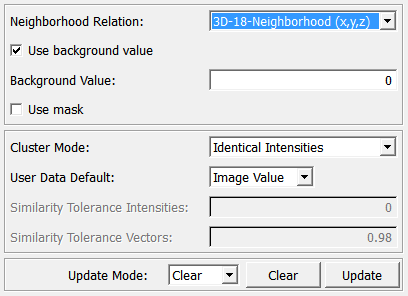ComputeConnectedComponents¶
- MLModule¶
author
package
dll
definition
see also
ConnectedComponentsToImage,FilterConnectedComponents,ConnectedComponentsInfokeywords
Purpose¶
The module ComputeConnectedComponents computes voxel clusters as connected components.
Details¶
A connected component is a set of neighboring voxels with similar values. The similarity function can vary, it can be the identity (neighboring voxels need the exact same value) or it can be that the difference of the voxel values needs to be smaller than some epsilon.
The module can process both scalar and vector images. The similarity of vectors is computed as the dot product, which must be greater than Similarity Tolerance Vectors.
If the module should work on a scalar image but the Cluster Mode is set to SimilarVectorDirections, the module will internally switch to the cluster mode SimilarIntensities.
If the module should work on a vector image but the cluster mode is set to SimilarIntensities or IdenticalIntensities, the module will internally switch to the cluster mode SimilarVectorDirections.
The output of this module is a Base structure containing the cluster information as well as selection/filtering information.
Note
The module only works on the first X/Y/Z dimension. It only computes clusters for values in the layer of the C/T/U dimensions. For computing clusters in higher C/T/U dimensions, use SubImage to ‘move’ the higher dimensions in C/T/U to the first entry.
Windows¶
Default Panel¶

Input Fields¶
input0¶
- name: input0, type: Image¶
Input image where the voxels are to be clustered.
input1¶
Output Fields¶
outClusters¶
- name: outClusters, type: SelectedClusters(MLBase)¶
For accessing this object via scripting, see the Scripting Reference:
MLSelectedClustersWrapper.
Parameter Fields¶
Field Index¶
|
|
|
|
|
|
|
|
|
|
|
|
|
|
|
Visible Fields¶
Update Mode¶
- name: updateMode, type: Enum, default: AutoClear¶
Defines the update behavior of this module.
Values:
Title |
Name |
Description |
|---|---|---|
Clear |
AutoClear |
On any input or parameter field change, the module clears its output. |
Update |
AutoUpdate |
On any input or parameter field, the module computes the output cluster structure anew. |
Update¶
- name: update, type: Trigger¶
When pressed, the module computes its output cluster structure anew.
Clear¶
- name: clear, type: Trigger¶
When pressed, the module’s output is cleared.
Neighborhood Relation¶
- name: neighborhoodRelation, type: Enum, default: NBH_3D_18_XYZ¶
Defines the neighborhood voxel relation that is used to compute the clusters.
Values:
Title |
Name |
|---|---|
2D-4-Neighborhood (x,y) |
NBH_2D_4_XY |
2D-8-Neighborhood (x,y) |
NBH_2D_8_XY |
3D-6-Neighborhood (x,y,z) |
NBH_3D_6_XYZ |
3D-18-Neighborhood (x,y,z) |
NBH_3D_18_XYZ |
3D-26-Neighborhood (x,y,z) |
NBH_3D_26_XYZ |
Background Value¶
- name: backgroundValue, type: Double, default: 0¶
Sets a background value for the cluster computation; all voxels with this value are considered background, regardless of whether they are connected by a neighborhood relation.
Use Background Value¶
- name: useBackgroundValue, type: Bool, default: TRUE¶
If checked, the background value is ignored and all voxels are subject to clustering.
Use Mask¶
- name: useMask, type: Bool, default: FALSE¶
If checked, the module expects an attached mask image; only voxels where the mask image is != 0 are considered for the cluster analysis and all other voxels will be considered background voxels.
Cluster Mode¶
- name: clusterMode, type: Enum, default: IdenticalIntensities¶
Defines the similarity function for clustering.
Values:
Title |
Name |
Description |
|---|---|---|
Identical Intensities |
IdenticalIntensities |
Scalar: Neighboring voxels need to have the exact same value. |
Similar Intensities |
SimilarIntensities |
Scalar: The difference of neighboring voxel values needs to be less or equal the value of |
Similar Vector Directions |
SimilarVectorDirections |
Vector: The dot product of neighboring voxel vectors needs to be greater or equal the value of |
User Data Default¶
- name: userDataDefault, type: Enum, default: ImageValue¶
Defines the value that is set as default to the user data.
Note that this option is only available if the
Cluster Modeis set to Identical Intensities.For the other modes, the cluster size in milliliters is set as user data by default.
Values:
Title |
Name |
Description |
|---|---|---|
Image Value |
ImageValue |
The image value is set as user data. |
Volume In Ml |
VolumeInMl |
The cluster size in milliliter is set as user data. |
Similarity Tolerance Intensities¶
- name: similarityToleranceIntensities, type: Double, default: 0¶
Sets the epsilon value for scalar value comparison.
Similarity Tolerance Vectors¶
- name: similarityToleranceVectors, type: Double, default: 0.98¶
Sets the epsilon value for vector direction comparison.